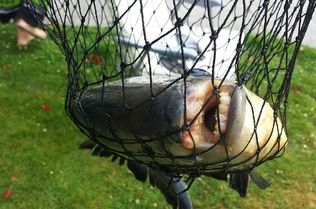
John Denton caught what he believes to be a pacu, a relative of the piranha, in Lake Ki over the weekend. The fish is being held at Cabela’s.
By Jim Davis, The Herald
John Denton hoped to catch a perch or bluegill on Sunday when he cast his line into Lake Ki, northwest of Marysville.
What he caught was something entirely different.
“Bang, there it was,” Denton said. “It’s a pretty big fish, a big ol’ herking fish.”
The fish he pulled out of the water was what looks like a pacu, an omnivorous South American freshwater fish that’s related to the piranha. The pacu is not nearly as ferocious as its cousin — it eats mainly fruit and vegetables and is known as the vegetarian piranha.
Like their cousins, pacu do have big teeth.
Denton’s fish weighs about four to five pounds and it took him about 20 minutes to reel it onto the dock in his back yard. He was using a worm and a hook known as a wedding ring.
By the time he got it into his net, his whole neighborhood came to see what was happening.
“Every neighbor I never met in this cul-de-sac I met yesterday,” Denton said.
One of the neighbors used to work at an aquarium and said he believed the fish was a pacu.
“Obviously it’s outgrown someone’s fish tank and they threw it in,” Denton said. “I don’t know how long it’s been there; it’s a big fish for an aquarium.”
Denton, 40, who’s a commercial painter for Mehrer Drywall, kept the fish alive by keeping it in a cooler of water: “My neighbor’s daughter kept pouring water in there all the time.”
Denton’s wife works at the Tulalip Cabela’s, where they have large fish tanks in the back of the store. Cabela’s agreed to hold on to the fish until the Washington Department of Fish & Wildlife could give them direction on what to do.
Katie Sanford, Cabela’s retail marketing manager, said the fish was still doing its fishy things on Monday afternoon. She said they had been doing some research on what it needs and what it eats.
“It looks like a really cute fish until it opens its mouth and you see its teeth,” Sanford said.
People have caught the pacu in lakes around Snohomish County, said Jeff Holmes, of Fish & Wildlife. In 1994, an 18-inch pacu was pulled out of Silver Lake in Everett.
“They’re a warm water fish and the odds of them establishing a population here are very low, if not impossible,” Holmes said.
Holmes said a biologist will confirm whether the fish is a pacu. He noted that pacu have recently been featured on the popular cable show “River Monsters” and that may be shading people’s opinions.
Mike Kirkham, a manager at The Fish Store, a Seattle aquarium and tropical fish business, saw photos of the fish and said he believes it is a pacu.
He’s been at the store for a decade and has heard several stories of people finding pacu in lakes in the Puget Sound area. The warm water fish can’t survive Northwest winters.
“In the fall, they tend to just die and float to the surface,” Kirkham said.
The fish can grow up to three or four feet long. He urged people against dumping unwanted pacu into waters around here. Instead, they should call pet shops or post advertisements to get rid of the unwanted pets. He said his shop doesn’t sale sell pacus, red-tail catfish or oscars because those species grow too large, making them prone to dumping.
For Denton, the fish created a keeper of a story.
“It was a pretty amazing experience,” Denton said. “I’ll never forget it.”
Jim Davis; 425-339-3097; jdavis@heraldnet.com
What are pacu?
Pacu are omnivorous South American freshwater fish that are related to the piranha. They have square, straight teeth that resemble a human’s. They can grow to 3 feet long and 55 pounds in the wild – much larger than a piranha.
Pacu are often sold as “Vegetarian Piranhas” to home aquarium owners. A pacu named Swish lived for two decades in a tank at a restaurant in Seattle’s International District.








